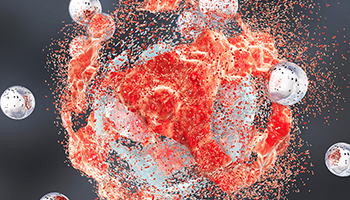HOW CAN WE HELP YOU? Call 1-800-TRY-CHOP
In This Section
Can Boosting an Oncogene Make Cancer Cells More Vulnerable to Chemotherapy?

The findings:
Oncogenes such as MYC are notorious troublemakers that promote cancer. Previous research strategies have focused on finding ways to quiet down levels of MYC; however, basic scientists at Children’s Hospital of Philadelphia took the opposite approach. In preclinical models, they increased MYC activity in combination with conventional chemotherapy for Burkitt lymphoma to boost an anti-cancer response. The tumor cells became more sensitive to the drugs, and cancer cell death increased.
Why it matters:
Researchers have identified a pressing need to target MYC-driven cancers, which account for half of all human cancers, including Burkitt lymphomas, a cancer of the lymphatic system that affects children and adults. This study suggests a novel approach that capitalizes on MYC’s cell death (or suicide)-triggering properties to make chemotherapy more successful and efficient. The study team’s findings about transiently hyper-activating an oncogene also has translational relevance. Better understanding of MYC’s mechanisms of action in triggering cell death and how it interacts with existing standards of care could lead to more targeted therapies and improve outcomes for patients with refractory lymphomas.
Who conducted the study:
Colleen Harrington, a graduate student in the Division of Cancer Pathobiology at CHOP, was first author of the study and collaborated closely with Elena Sotillo, PhD, in the lab of Andrei Thomas-Tikhonenko, PhD, chief of the Division of Cancer Pathobiology at CHOP, director of the Experimental Pathology Branch, and Mildred L. Roeckle Endowed Chair in Pathology. Dr. Thomas-Tikhonenko also is a professor of Professor of Pathology & Laboratory Medicine and Pediatrics at the Perelman School of Medicine at the University of Pennsylvania.
How they did it:
The study team studied cells from chemoresistant Burkitt lymphoma tumors. They used lithium chloride or CHIR99021 as small molecule inhibitors of glycogen synthase kinase 3b (GSK-3β) to highjack biological pathways that in turn elevated MYC. Increasing MYC predisposed the cells to die in combination with doxorubicin, a type of chemotherapy. The scientists demonstrated “high MYC” cells were more sensitive to doxorubicin, and “low MYC” cells were much more resistant to the drug.
The study team looked deeper into the mechanisms behind why MYC is a “master regulator of chemosensitivity in refractory B-cell lymphomas” and its role in cell death. They demonstrated that MYC is a key GSK-3β target. When GSK-3β is inhibited and MYC’s abundance increases, the study team suggests this interplay facilitates engagement of death receptors acting in the extrinsic, death-receptor-mediated apoptotic pathway.
“In our studies done in the context of chemotherapy, when tumor cells are at the brink of death, amplifying MYC pushes them over the edge,” Dr. Thomas-Tikhonenko said.
Quick thoughts:
“The most exciting thing about the study is it demonstrates the ability to have more targeted therapies for MYC-driven cancers that have been difficult to pharmacologically inhibit,” Harrington said. “If lithium can be repurposed as part of combination therapy for Burkitt lymphoma and other cancers, the path to a translational treatment could be short.”
Dr. Thomas-Tikhonenko added: “While much more work needs to occur before these results could become an approved therapy for relapsed or refractory cancers, it is certainly tantalizing to think a drug that is well-known, inexpensive, and can be given to patients safely could make their tumors more sensitive to cancer drugs.”
What’s next:
With their new understanding of the beneficial paradox of increasing MYC in the context of chemotherapy, the study team plans to investigate how they can leverage this strategy for other MYC-driven cancers. In the future, they foresee designing a clinical trial including pediatric patients resistant to chemotherapy to test MYC’s effectiveness as a chemosensitizer. Another next step would be to identify potential biomarkers that would suggest when certain types of tumors would be most sensitive to increased MYC levels, perhaps immediately prior to chemotherapy.
Where the study was published:
The article “Transient stabilization, rather than inhibition, of MYC amplifies extrinsic apoptosis and therapeutic responses in refractory B-cell lymphoma” appeared in the journal Leukemia.
Where to learn more:
Find out more about the study in a CHOP news brief. And visit the Division of Cancer Pathobiology at CHOP to learn more about the researchers and their current research projects.


